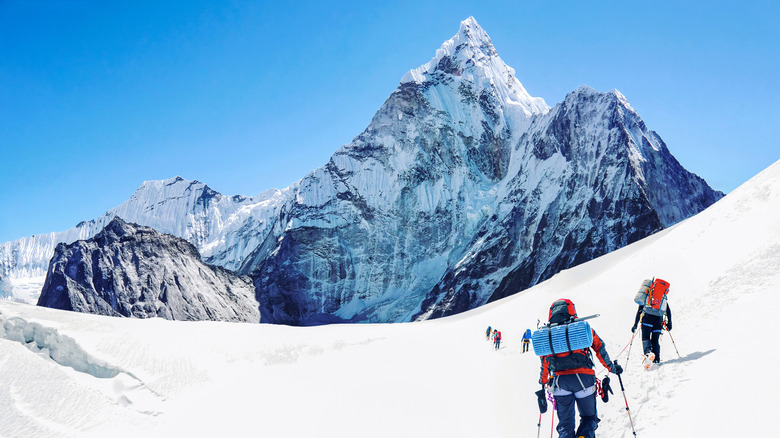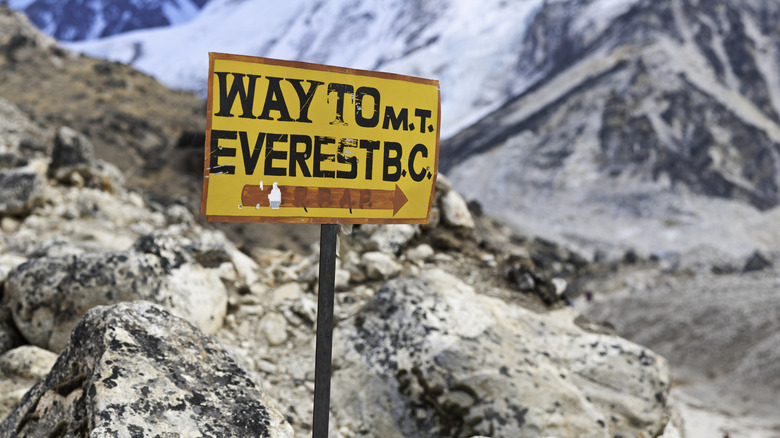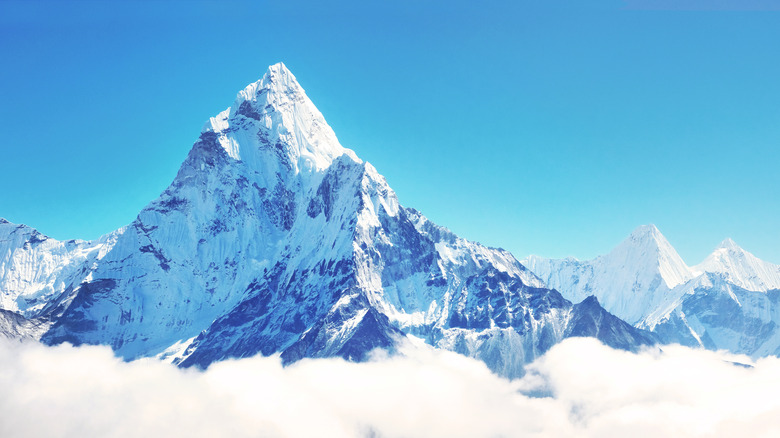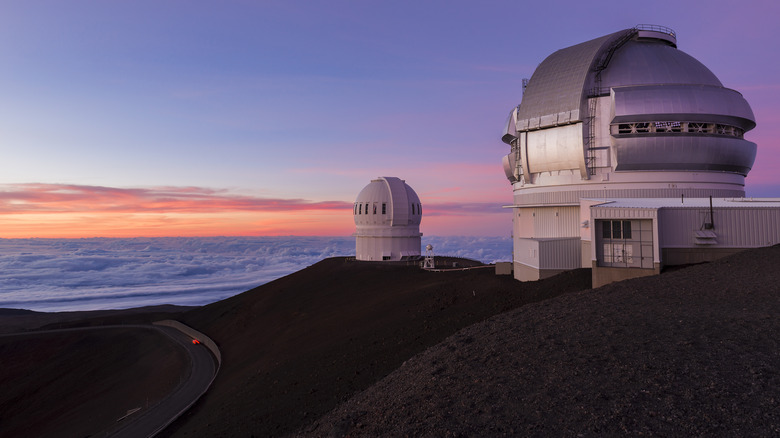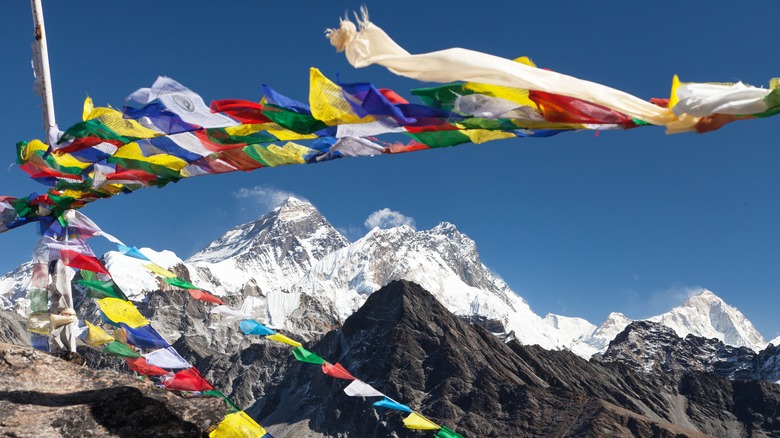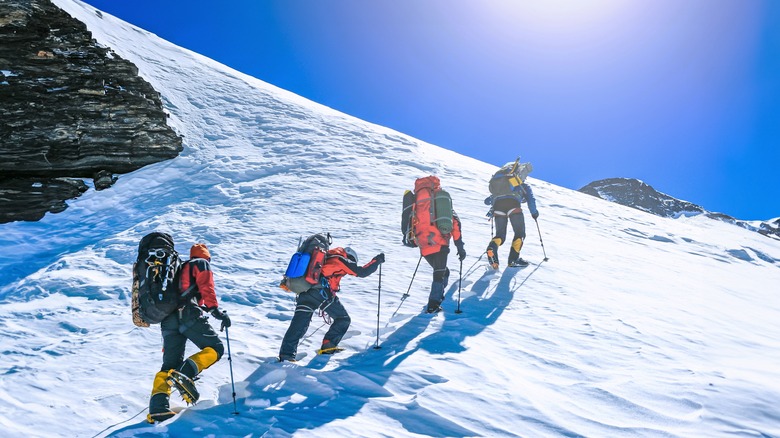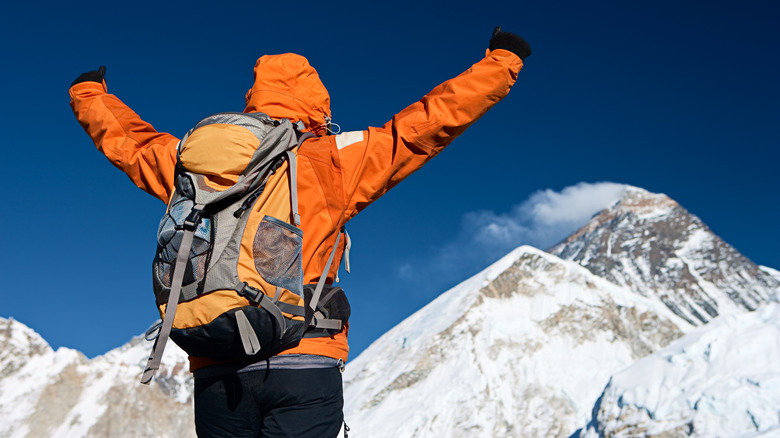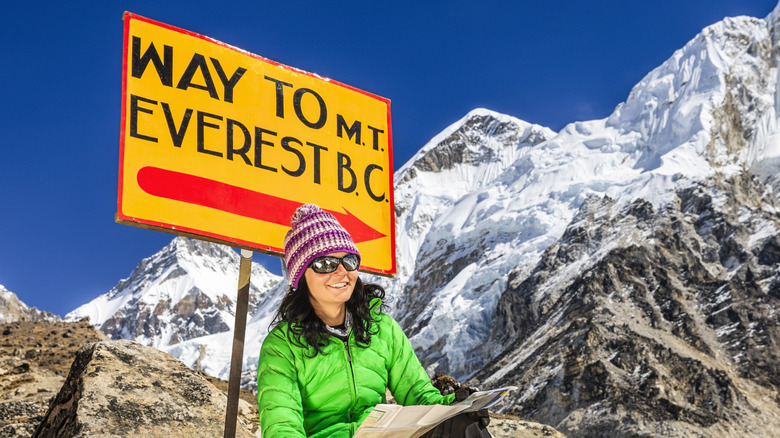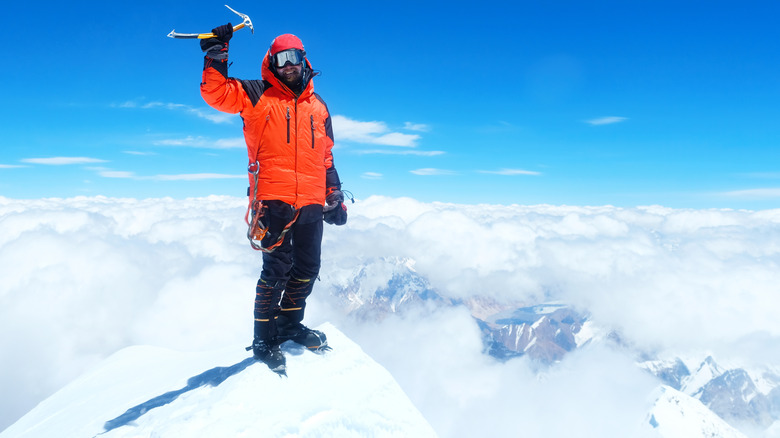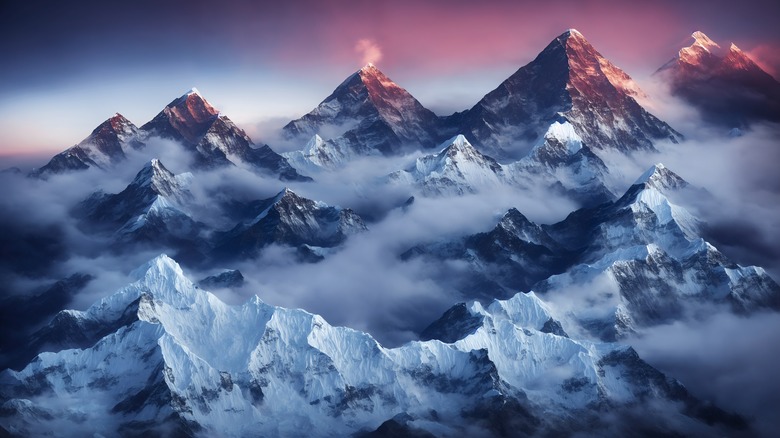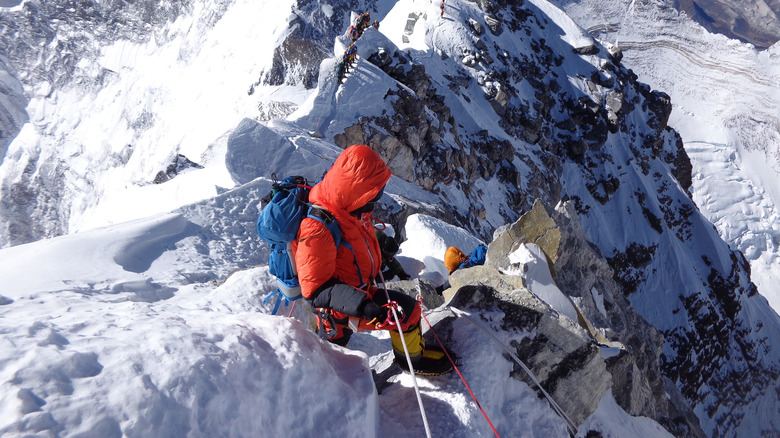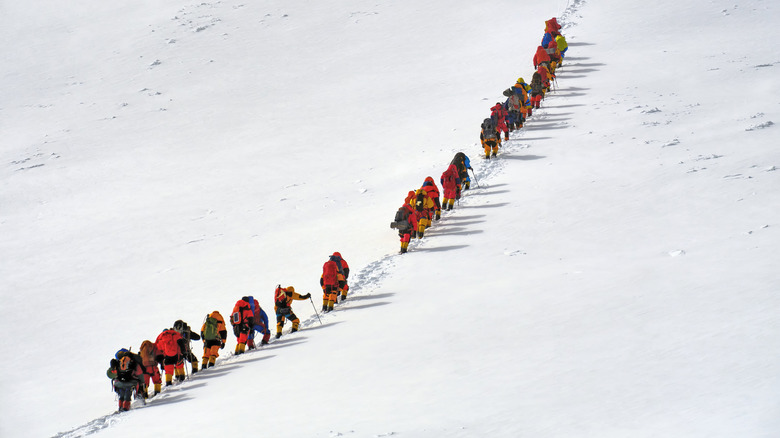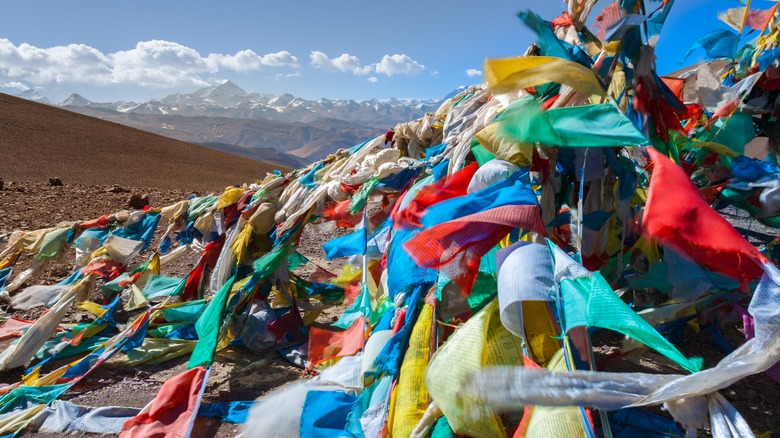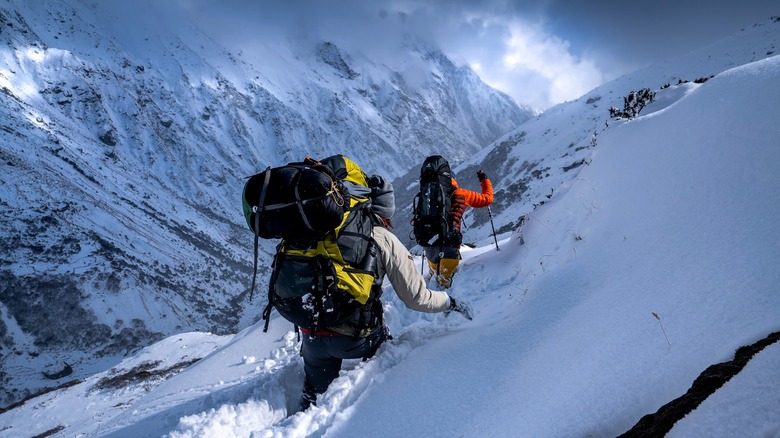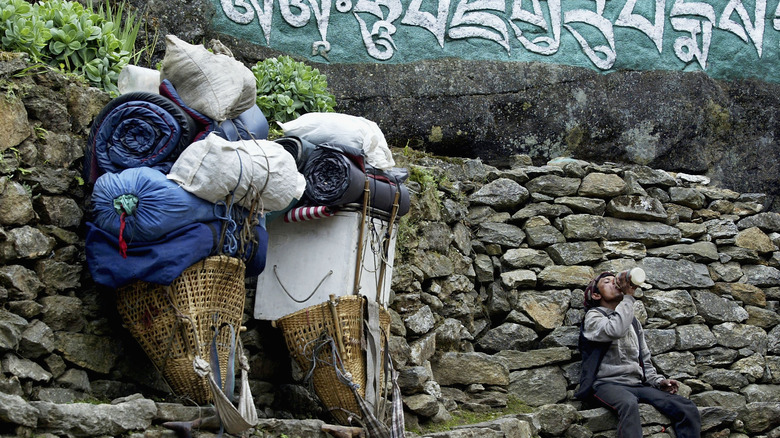Fascinating Facts About Mt. Everest
The world's tallest mountain has a reputation just as large. Mt. Everest is renowned across the globe for its intimidating height and extreme, icy conditions, yet still manages to attract hundreds of daredevil climbers every year — some of whom never make it back to base camp.
Thanks to its age and legendary stature, Everest remains a point of intrigue for climbers and non-climbers alike. Centuries before the British discovered its status as the highest point on Earth, Everest and the surrounding Himalayan mountains were considered sacred to the Nepalese people, while Tibetan Buddhists have long believed that Miyolangsangma, the Buddhist goddess of Inexhaustible Giving, lives upon the mountaintop.
For many of us, the mysteries of Everest will remain mysteries. However, its peak has existed for millennia, making it a treasure trove of quirky facts and a terrifying — even deadly — history, which we're still uncovering to this day.
It's over 60 million years old
Mt. Everest is no spring chicken. The mountain first sprouted into existence around 60 million years ago when the Indian Plate — which was at that point moving by roughly 5.9 inches per year — collided with the continent of EuroAsia.
As the two tectonic plates met, they pushed up against each other enough to go vertical along a span of 1,550 miles. Today, you probably know this collision zone as the Himalayas. Of course, these processes don't happen overnight; it's thought that Everest reached a height of around 16,404 feet between 15 to 17 million years ago, which means it took another 45 million years or so to hit its current altitude of 29,032 feet.
Mountain ranges across the world have a similar backstory, but it just so happens that scientists aren't entirely confident about how the Himalayas managed to reach such dizzying heights. According to Science Focus, a 2023 study found that the area was already bafflingly tall before the tectonic collision, suggesting there are still a few mysteries to solve about Everest's origins.
It's still growing
While it has slowed down somewhat, the Indian Plate is still moving to this day. It continues to hit the Tibetan Plateau at a speed of 67mm per year, which means Everest grows by about .16 inches per year, according to the BBC.
The rest of the Himalayas are growing at an even more rapid rate, rising by .4 inches annually. Aside from mountainous growth, this ongoing collision is the reason behind Nepal's infamous seismic activity. As pressure builds up between the plates, energy is eventually released in the form of an earthquake. The country has been hit by multiple deadly quakes over the centuries, with nearly 9,000 people killed by the 8.1 earthquake in 2015 that also triggered Everest's deadliest avalanche to date.
These earthquakes often lead to another sudden jump in height for Everest. However, they can also cause it to shrink. Scientists believe this was the case in 2015, when Everest's height decreased by one inch after the natural disaster, but areas of the mountain closer to Kathmandu surged by over three feet, according to National Geographic.
It's not actually the tallest mountain
If we're talking purely about height, Mt. Everest doesn't take home the gold. From base to peak, the tallest mountain in the world is actually Mauna Kea, a dormant volcano in Hawaii that last erupted in 2600 BC. With a height of 10,205 meters (33,481 feet), it's over a mile taller than Mt. Everest.
However, the reason why Everest is usually given the title of the world's tallest mountain is because over half of Mauna Kea's height sits underwater in the Pacific Ocean. Its peak is especially popular with astronomers, who have taken advantage of Hawaii's pleasant climate and optimal viewing conditions to construct multiple observatories and telescopes over the years — a feat that would be considerably more challenging up on Everest. It's also popular with climbers, who can claim bragging rights for technically climbing the tallest mountain in the world (even if they did start halfway to the top).
We're not pronouncing its name properly
Mt. Everest gets its name from Welsh geographer, Colonel Sir George Everest, the first British Surveyor General of India. The colonel actually refused the honor, insisting that his surname was impossible to write in Hindi and was too tough for local residents to pronounce. As it turns out, we're still pronouncing his surname wrong to this day. "Everest" is said "eve-rest," but the mispronunciation has become commonplace over the decades.
The mountain also has a handful of other names. In Tibet, Everest is known as "Chomolungma" (which translates to "The Holy Mother"), and the official Chinese name is "Zhūmùlǎngmǎ Fēng" ("Holy Mother Peak"). While original British surveyors in the 1800s planned on preserving local names, it was Andrew Waugh — Everest's successor as Surveyor General — who insisted that there were too many options to commit to just one. He instead opted to give the peak the totally new name. As of the 1960s, however, Nepal officially recognizes its name as "Sagarmāthā," which means "goddess of the sky."
Climbing it isn't cheap
Climbing Everest doesn't just take its toll on your body but your wallet, too. It can cost anywhere between $30,000 and $60,000 — with some paying as much as $220,000 — to reach the top, and it's only getting more expensive.
A huge chunk of this money goes towards a mandatory permit. The Nepal government currently charges $11,000 per person (or $904 if you're a Nepali citizen) to climb Mt. Everest. This money is used to maintain the mountain, so it goes towards a good cause, and those without one are technically considered illegal trespassers (and risk not being rescued in case of emergency). From 2025, this fee will soar to $15,000 per person, according to the Kathmandu Post.
Other expenses include airfare, personal gear, a liaison officer, food, sleeping equipment, the round-trip fee for a Sherpa guide, and oxygen tanks. The latter alone costs around $550 a tank, and with the recommended minimum being five or six per expedition, climbers can expect to spend roughly $3,000 on oxygen alone. You are also expected to pay a $4,000 garbage deposit — part of an initiative introduced by the Nepal government to encourage the cleanup of Everest's increasingly littered peak — which will be refunded if you manage to bring back around 17.5 pounds of trash at the end of your trip.
It takes over a month to reach the top
Reaching the top of Everest typically takes over a month. On average, climbers spend seven to nine weeks trying to hit the summit, with every stage meticulously planned to minimize the risk of fatal accidents.
Before you even hit the Himalayas, it typically takes around a week to arrange all the necessary permits and formalities in Kathmandu. You then proceed to Everest Base Camp, which in itself is a trek that lasts anywhere between a week and two weeks. This climb is purposefully slow, in order to give climbers a chance to acclimatize to the altitude. Once at Base Camp, this acclimatization then drags on for another few weeks, with several excursions held to speed up the process.
Once you're ready for the big climb, this can last for two or three more weeks. The final ascent to the summit takes place over less than a day. Fortunately, the way back down is much quicker, but it's also considered more dangerous. According to The Hindu, 84% of non-Sherpa deaths on Everest have been recorded during the descent.
Multiple climbers have set world records
In May 1953, Edmund Hillary and Sherpa mountaineer Tenzing Norgay became the first people confirmed to have reached the top of Mt. Everest. Since then, numerous records have been set by the thousands scaling its snowy peaks. Nepali Sherpa Kami Rita, for example, holds the world record for the most successful summits, having reached the peak for the 27th time in May 2023, while Jordan Romero famously became the youngest person to climb Mt. Everest at the age of just 13 years, 10 months, and 10 days old.
Other Mount Everest record-holders include Junko Tabei, who became the first woman to reach the summit in 1975, and Babu Chiri Sherpa, who's held the record for the longest time spent at the summit without supplementary oxygen (21 hours) since 1999. Climbing Everest 11 times prior to a deadly fall on the mountain in 2001, he previously also held the record for the fastest ascent, which he completed in just 16 hours and 56 minutes.
There are disputes over who climbed it first
Officially, Edmund Hillary and Tenzing Norgay are the first people to reach the summit. However, there are those who believe George Mallory beat them to it 29 years prior. Mallory — who disappeared for 70 years after an accident on his third climb of Everest — is already known to be part of the first group to ascend higher than 8,000 meters (26,247 feet). When his body was finally found in 1999, it was missing a picture of his wife Ruth, which he had vowed to place on the summit, raising questions of whether he may have managed to reach the top.
Hillary himself admitted that it was likely Mallory summited Everest first. However, Mallory's own family are reluctant to name him the record-holder. "My guess is they did make the summit, but probably not until very late in the day," his own son, John, told the BBC's Radio 4. "To me, the only way you achieve a summit is to come back alive. The job is only half done if you don't get down again."
The Two O'Clock Rule is life or death
Beautiful though it may be, nighttime views aren't really a thing at the summit. The Two O'Clock Rule mandates that anyone hoping to reach the top of Everest needs to do so by 2 p.m. Otherwise, they'll need to turn around and descend to high camp. Failure to do so may mean you won't make it back on time, instead suffering nighttime windchills of -90 degrees Fahrenheit and potential snow blindness.
Surviving a night at the summit is near-impossible. However, in 2006, Lincoln Hall — an Australian mountaineer making his second summit attempt — suffered a suspected cerebral edema and was left by his Sherpa guides after they assumed he had died. The next day, he was discovered by another team without oxygen, food, water, or clothes on his top half, with The Sydney Morning Herald quoting him as saying, "I imagine you're surprised to see me here." Despite ultimately losing his fingertips and a toe to frostbite, he survived the incident in relatively good health (although this is definitely not the norm for those who fail to follow the Two O'Clock Rule).
It's claimed over 300 lives
While it isn't the mountain with the highest death rate, over 300 people have died due to avalanches, serac collapses, cold temperatures, falls, and altitude sickness, with 2023 claiming 18 lives and becoming the deadliest year in history. In fact, there were only two years with no official deaths since records began: 1977 and 2020 (when permits were temporarily suspended by the Nepal government due to the COVID-19 pandemic).
Considering how tough it is to scale Everest, retrieving the dead is extremely challenging — not to mention expensive, with repatriation costing as much as $70,000. It's thought that there are over 200 bodies frozen in place on Everest, with Green Boots — a climber, thought to be Tsewang Paljor, whose body became a landmark until it was later relocated out of respect — one of the most famous. Those embarking upon the climb are made well aware of the risk that they won't come home. Body disposal forms must be completed in advance, specifying your preferences and requiring the signature of your spouse or next of kin, just in case.
Traffic jams are incredibly common
Despite the costs and dangers, the number of climbers trying to conquer Everest has surged in recent years. May is usually considered the best (and safest) month to attempt the summit, but it can also be extremely busy as everyone tries to take advantage of this window, resulting in long lines along the mountaintop.
The closer you are to the summit, the more dangerous this overcrowding can be. Some have suggested that these traffic jams have been a factor in multiple deaths, due to the fact you're spending more time at a high altitude and wasting precious oxygen while standing in line. One 27-year-old mountaineer died in 2022 after being stuck in traffic for over 12 hours. However, others have described the situation as more inconvenient than perilous. "It was like standing in line on a busy weekend at a ski resort," one climber told National Geographic. "Frustrating, but mostly boring — not what you expect — to have to stand in line on Everest."
You can visit two countries at the top
Mt. Everest, like the rest of the Himalayas, straddles the border of Nepal and Tibet, an autonomous region of China. The majority of climbers begin their journey on the Nepal side — which is considerably easier to access from a visa and logistics perspective — but it's also possible to begin in Tibet (also known as Everest North), which boasts a lower Base Camp.
Once you're at the top, however, you can theoretically pass from one country to the other. The summit of Everest is shared between Nepal and Tibet, so you can technically tick both off your bucket list at the same time. Back in 2021, China floated the idea of enforcing a separation line to prevent climbers from the Nepalese side potentially spreading COVID-19, before eventually pausing all ascensions altogether. Spring 2024 marks the return of Everest expeditions in Tibet, albeit with a dramatically reduced number of maximum annual permits.
It has a risky death zone
Once you pass 26,000 feet, you have officially entered Mt. Everest's death zone. As the name suggests, this isn't somewhere you want to linger for too long, and is where the majority of deaths occur on Everest.
At this altitude, oxygen falls by 40% and becomes so limited that the body's cells begin to die. In the worst case scenario, it can cause brain swelling — also known as a high-altitude cerebral edema – which in turn leads to nausea, vomiting, impaired judgment, and difficulty thinking. Your heart rate may also increase to rates of up to 140 beats per minute, increasing the risk of a heart attack or stroke.
For that reason, climbers are advised not to spend longer than 16 to 20 hours (48 hours with supplementary oxygen, at a push) in this zone. Helicopters also struggle to fly properly in air this thin, which is a huge factor in why the majority of those who fall victim to the death zone are left there after their passing.
Sherpa guides are necessary
The Sherpa people have been indigenous to the Himalayas for over 500 years. To the Sherpa, Everest is sacred. For many, it's also a source of income, with their services worth thousands of dollars to those hoping to scale Everest's summit.
Sherpa guides — many of whom have reached the peak of Everest on multiple occasions — help climbers with the practicalities of their journey, such as organizing the routes, constructing the camps, and carrying oxygen, food supplies, and other equipment. Having lived at high altitudes for the majority of their lives, they know exactly what to do in case of an emergency, and are often the difference between a successful and an unsuccessful summit. British mountaineer Kenton Cool once described them as "the backbone of any expedition" to the BBC.
Considering their expertise, there's been a big push for Sherpa to be paid more for their efforts, and some have even left the industry altogether. The average Sherpa guide takes home around $6000 per climbing season for their efforts, which is well above the national average in Nepal, but still dims in comparison to the millions raked in by Everest's climbing economy every year.
